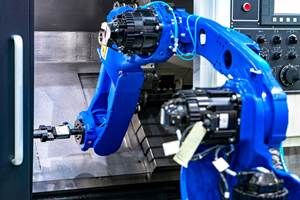Lessons Learned in Deep Hole Drilling
Of course when it comes to deep hole drilling, the tooling, the fixturing and the automation are all essential, but the part that caught my attention during a recent UNISIG event was the focus on mold-specific industry solutions, especially its USC-M series machines that allow multiple operations to be performed on all workpiece sides with one setup.
Of course when it comes to deep hole drilling, the tooling, the fixturing and the automation are all essential, but the part that caught my attention during a recent UNISIG event was the focus on mold-specific industry solutions, especially its USC-M series machines that allow multiple operations to be performed on all workpiece sides with one setup.
UNISIG President Tanya Palmer and CEO Anthony Fettig kicked off the day of talks and tours, giving invited press the low down on the company’s humble beginnings as well as lessons in deep hole drilling and updates on new and proven related machining technology, all designed and built in their Menomonee Falls, Wisconsin facility.
Topics included machine and process overviews, as well as industry spotlights, including the mold industry, and firearms production. Editors learned how machines come together to produce extremely accurate, deep holes for customers.
The company started back in 1973 as a special machine design shop by John Korosec, Tanya Palmer’s father. Today, Unisig is part of Entrust and has service available in the U.S., China, Germany, India and the Far East. European sales and service are offered by a daughter company in Germany, UNISIG GmbH. The company also has factory-trained service providers in China, India and Singapore for installations and service. We build everything in the U.S., but our expertise follows the machinery here and overseas,” Fettig says.
Unisig develops specialized drilling equipment, supported by years of experience creating specific equipment to solve specific needs in deep hole drilling applications. These systems, complete with advanced controls programming and precision components, are capable of accurate holes in deep hole drilling applications.
A deep hole is defined by its depth-to-diameter ratio (D:d) of typically 10:1 or greater, sometimes exceeding extreme depth of 400:1. Common CNC machining centers may be retrofitted to perform selected deep hole drilling processes, but according to Unisig, this setup is limited in capabilities, requires more involved setup and risks a higher rejection rate.
Its USC-M Series machines combine high accuracy machining, five-axis positioning and deep hole drilling in a single machine. The machines are designed specifically for the materials, dimensions, complexities and tolerances found in the mold industry. For example, the design allows both large and small parts to be machined on four sides without repositioning due to the machine travels, headstock and table design for access.
Standard features include a Heidenhain iTNC 6407-AXS control, contour milling and complex machining, thread milling at compound angles and process monitoring with automatic interrupt.
Typical add-on requests from customers include Heidenhain glass scales for direct feedback to improve axis positioning accuracy and repeatability; wireless probe for workpiece verification, job set up and on-the-machine inspection; automatic radial and axial tool setup, a Kinematics OPT to measure the rotary axis position and minimize spatial error; automatic toolchangers up to 120 tools; dual pallet loaders, FCS modular fixturing, refrigerant chiller, mist and smoke collector, remote handwheel and remote tool management.
This series also has unlimited deep hole drilling tool options, including conventional gundrills, inserted gundrills, high feed gundrills, BTA deep hole drilling tools, spade drills and high-performance coolant-fed drills. Automation options all significant unattended machining cycles.
“Many people dismiss deep hole drilling because they think it is old technology, but what they are missing is the performance and profit potential of this technology in the right machine,” Fettig says. Maybe it’s time to give deep hole drilling a second look.
Related Content
How to Automate Process and Design
Moldmakers can improve their operations and stop wasting time by taking these six steps for process and design automation.
Read MoreHow to Start Automating Your Moldmaking Operation
A few fundamentals of moldmaking automation include identifying key areas and places to avoid and addressing common concerns and roadblocks.
Read MoreDevelopments in High-Speed Machining Technology
There have been many exciting developments in high-speed machining relative to machining centers and controls, tooling and CAD/CAM systems.
Read MoreMoldMaking Technology's Most-Viewed Content 2022: Products
MMT shares the five top-viewed technologies, equipment and services of 2022 in each Engineer, Build, Maintain and Manage tenet based on Google Analytics.
Read MoreRead Next
How to Use Strategic Planning Tools, Data to Manage the Human Side of Business
Q&A with Marion Wells, MMT EAB member and founder of Human Asset Management.
Read MoreReasons to Use Fiber Lasers for Mold Cleaning
Fiber lasers offer a simplicity, speed, control and portability, minimizing mold cleaning risks.
Read MoreHow to Use Continuing Education to Remain Competitive in Moldmaking
Continued training helps moldmakers make tooling decisions and properly use the latest cutting tool to efficiently machine high-quality molds.
Read More















_300x250 3.png;maxWidth=300;quality=90)









_970x250 1.png;maxWidth=970;quality=90)